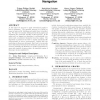216 search results - page 21 / 44 » The Complexity of Planning Problems With Simple Causal Graph... |
GIS
2008
ACM
14 years 8 months ago
2008
ACM
In this paper we propose to apply hierarchical graphs to indoor navigation. The intended purpose is to guide humans in large public buildings and assist them in wayfinding. We sta...
DCG
1998
13 years 7 months ago
1998
We present a simple and e cient paradigm for computing the exact solution of the motionplanning problem in environments with a low obstacle density. Such environments frequently o...
IJRR
2006
13 years 7 months ago
2006
Current technological developments and application-driven demands are bringing us closer to the realization of autonomous multirobot systems performing increasingly complex missio...
CP
1998
Springer
13 years 12 months ago
1998
Springer
The constraint paradigm provides powerful concepts to represent and solve different kinds of planning problems, e. g. factory scheduling. Factory scheduling is a demanding optimiz...
WAW
2009
Springer
14 years 2 months ago
2009
Springer
The Modularity-Q measure of community structure is known to falsely ascribe community structure to random graphs, at least when it is naively applied. Although Q is motivated by a ...

